Learn how to make chocolate at home using these chocolate-making tips.
Once you learn the basics, you'll be able to make delicious homemade chocolates that look amazing too.
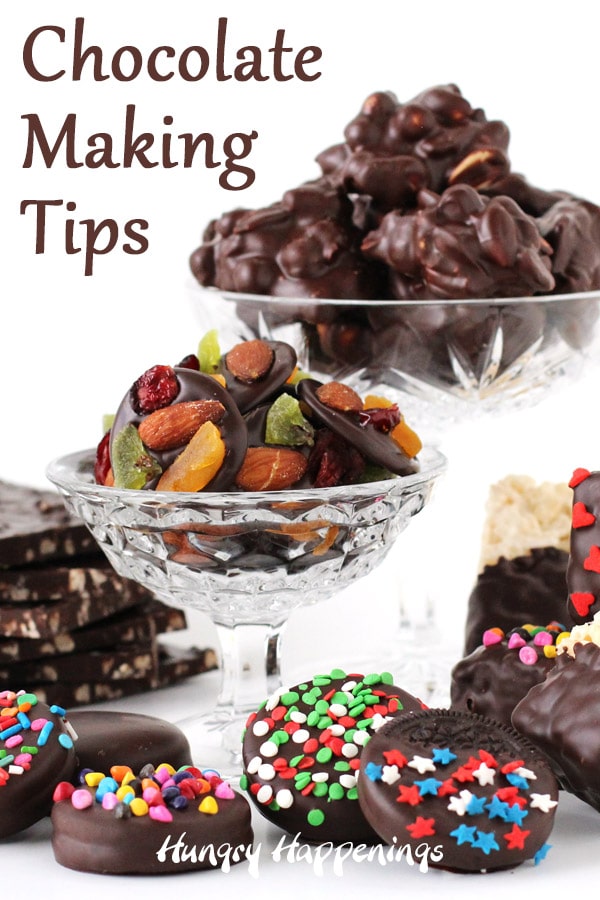
Thanks for stopping by to learn how to make homemade chocolates. I have been a chocolatier for over 30 years and am so excited to share these chocolate-making tips with you. I have been blogging since 2010 and have shared hundreds of chocolate recipes here on this blog.
Once you learn the basics, you can create amazing chocolate candies and desserts to share with family and friends.
If you prefer to learn visually, check out my Chocolate Making Course video series from The Sugar Academy.
In this tutorial you will learn:
- the difference between pure chocolate and compound chocolate
- how to melt and temper pure chocolate
- how to melt compound chocolate (also known as confectionery coating, candy melts,
almond bark, or melting wafers)
- how to melt compound chocolate (also known as confectionery coating, candy melts,
See these other tutorials for more information:
- how to color white chocolate and white confectionery coating
- how to paint candy molds using colored chocolate
- how to make and use modeling chocolate (candy clay)
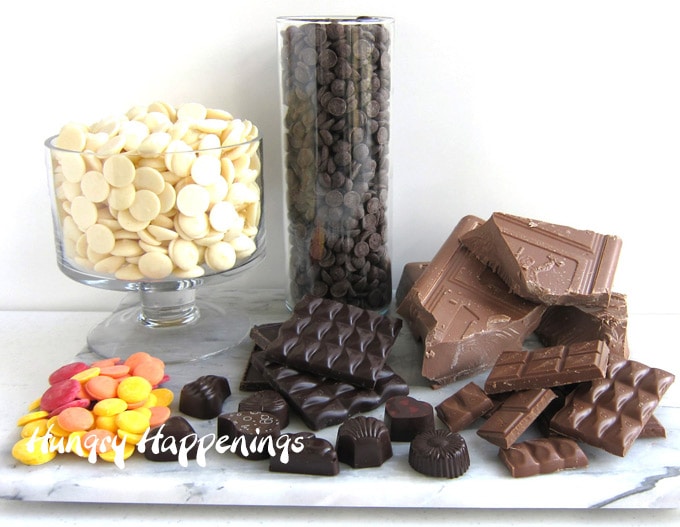
Let's start with the basics.
TYPES OF CHOCOLATE
There are several different types of chocolate that are available to the home cook for use in candy making:
Pure chocolate (real chocolate)
- contain cocoa butter
- has a luxuriously creamy texture and rich flavor
- must be properly tempered in order to set up correctly
- can be purchased in bars, blocks, wafers, pistoles (bean-shaped wafers), callets (slightly smaller wafers), and chips
- is available as:
- unsweetened (no sugar added)
- bittersweet (small amount of sugar added)
- semi-sweet (more sugar added)
- milk chocolate (milk powder and sugar added)
- white chocolate which can also contain cocoa butter but it doesn't contain any cocoa liquor, so technically it is not considered chocolate (But that is what it is called, so that's what we'll call it too!)
You can use pure chocolate to make:
- Hot Chocolate Bombs
- Artisan Chocolates decorated with Chocolate Transfer Sheets
- Chocolate Truffles
- Chocolate Cups filled with Chocolate Mousse
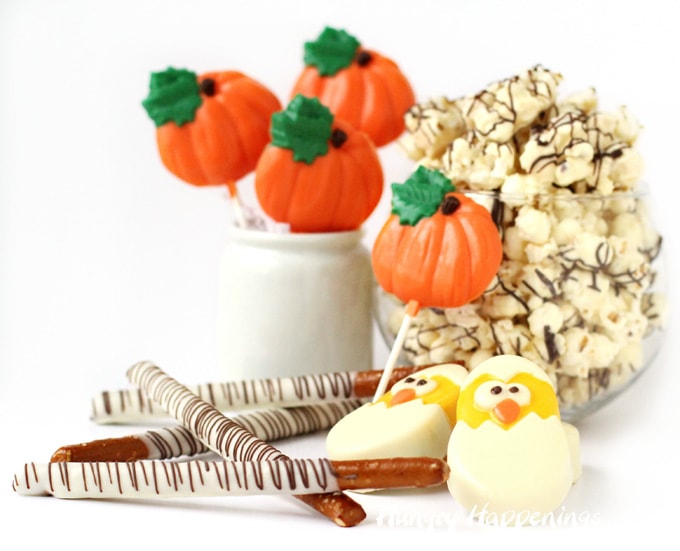
Compound Chocolate (also known as confectionery coating, Candy Melts, almond bark, or melting wafers)
- contain vegetable oil, typically palm kernel oil
- will melt and set up easily with little effort
- is not as creamy or as rich as pure chocolate, but it’s easy to use and has a very pleasant flavor
- is available in dark, light, white, and flavors like peanut butter, mint, and butterscotch
- can be colored using candy coloring but is also available in colored wafers
- is typically less expensive than pure chocolate
NOTE about compound chocolate and wax
- The melting point of compound chocolate is higher than that of pure chocolate which means that it will take longer to melt on your tongue which can give it a waxy feel in your mouth.
- However, there is no wax in compound chocolate, candy melts, or almond bark, as some people believe. What you are feeling on your tongue is palm kernel oil, not wax.
- Being cocoa butter melts at a lower temperature and melts quickly as soon as it hits your tongue, you will not feel this waxy sensation when eating pure chocolate.
You can use compound chocolate to make:
- White Chocolate Popcorn and a White Chocolate Popcorn Bowl
- Hand-painted Easter chocolates and lollipops
- Pretzel Pops
- Sprinkle Coated Chocolate Cups filled with ice cream or candy
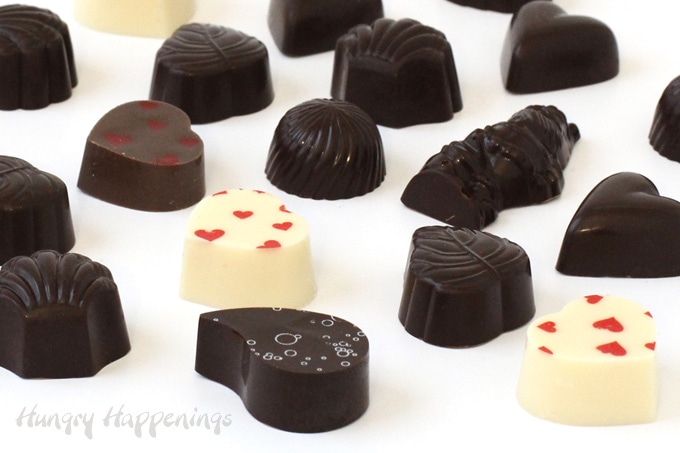
Buying chocolate for candy making.
I personally use Peters Burgundy (semi-sweet), Peter's Ultra (milk chocolate), and Callebaut dark, milk, and white chocolate callets for my chocolate making, but there are many other delicious brands of chocolate.
Choose the chocolate you like to eat. Everyone enjoys different flavors so you need to find your favorite.
my favorite pure chocolate brands
Some brands of chocolate I recommend using are available on Amazon.com.
I earn a small commission when you use the links below at NO extra cost to you.
 Peter's Gourmet Burgundy Di...Shop on Amazon
Peter's Gourmet Burgundy Di...Shop on Amazon  Callebaut No 811 Finest Bel...Shop on Amazon
Callebaut No 811 Finest Bel...Shop on Amazon  Belgian Milk Chocolate Baki...Shop on Amazon
Belgian Milk Chocolate Baki...Shop on Amazon popular brands of compound chocolate
I have created hundreds of recipes here on Hungry Happenings using compound chocolates (candy melts). I personally prefer the taste of Peter's Eastchester (dark), Westchester (milk), and Whitecaps, but they are not readily available unless you live near a cake & candy decorating store, so I often use Wilton Candy Melts for my projects.
You can find Wilton Candy Melts at most craft stores, at discount stores like Walmart, and at some grocery stores. You can also find Ghirardelli Melting Wafers and CandiQuik (or other brands of almond bark) at many grocery stores.
 Wilton Red Candy Melts® Ca...Shop on Amazon
Wilton Red Candy Melts® Ca...Shop on Amazon  Merkens Super White 1 lb Ba...Shop on Amazon
Merkens Super White 1 lb Ba...Shop on Amazon  Light Blue Vanilla Flavored...Shop on Amazon
Light Blue Vanilla Flavored...Shop on Amazon  Log House CandiQuik Candy C...Shop on Amazon
Log House CandiQuik Candy C...Shop on Amazon Store chocolates in a cool dry place away from direct sunlight. Pure chocolates have a shelf life of at least 18 months from the date of manufacturing and confectionery coating can last up to 12 months if stored properly.
Once you open the package, seal it well or place the chocolate in an airtight container.
I don't suggest refrigerating or freezing chocolate.
If chocolate or confectionery coating is kept in the refrigerator or freezer for too long it will become wet and sticky and might develop white spots.
If you do freeze or refrigerate your chocolates, you need to wrap them well and keep them wrapped as they thaw to avoid excessive condensation.
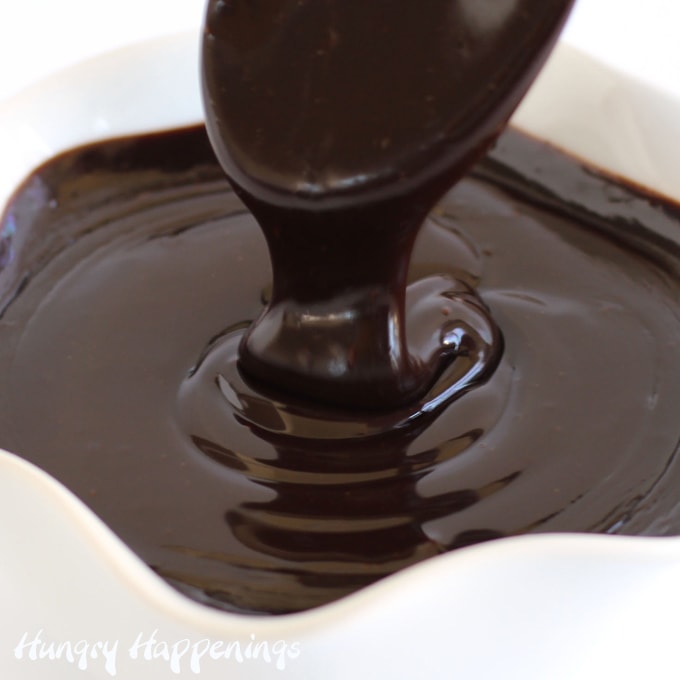
Learn how to melt chocolate.
First, you need to get your chocolate into small uniform-size pieces.
How to chop chocolate?
- If you are using a large block of chocolate or a candy bar, chop your chocolate into small uniform pieces. The best way to do this is to use a serrated knife to shave off small bits of chocolate.
- Place the knife blade on the edge of the chocolate block, and press down on the top of the knife while shaving off a small amount of chocolate. Then just chop any larger bits before using.
- You can also use a food processor to chop your chocolate. Add small chunks of chocolate to the bowl of the food processor and pulse until you have fine crumbs
- You can also grate the chocolate using a grating wheel in your food processor.
Melting chocolate in a double boiler.

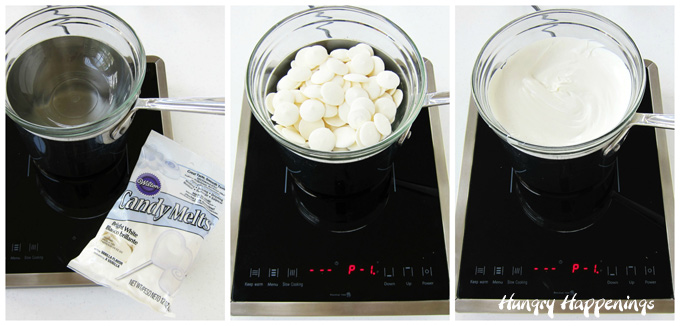
- Heat 1” of water over low heat in a saucepan.
- Place a bowl over the saucepan, being sure the bottom doesn't touch the water.
- Put chopped chocolate, wafers, or chips in the bowl and stir occasionally until melted.
- This process is slow. Do not raise the temperature to speed things up. If you do, you can burn your chocolate.
It is very important that you do not allow any water to come in contact with the chocolate. Chocolate mixed with a drop or a few drops of water will seize (stiffen or harden).
If this happens your only option is to add more liquid in order to get the chocolate smooth again. However, you can not use this thinned batch of chocolate for tempering or dipping as it will never harden properly.
All is not lost as you can turn it into a delicious chocolate ganache or use it for baking.
Melting chocolate in the microwave.
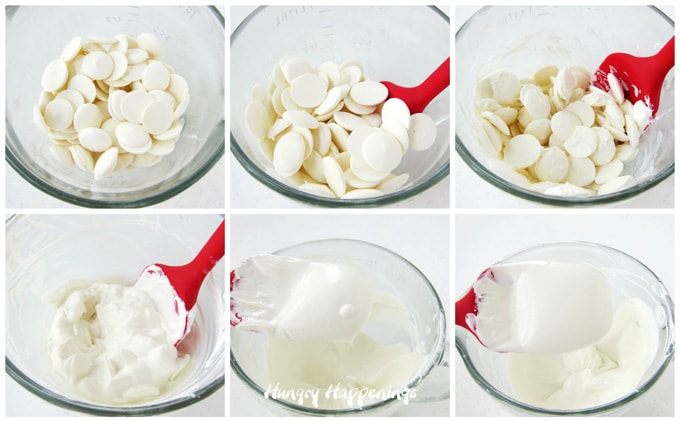
Every microwave is different so this is just a guideline, but it is safest to go slow and stir often. I always use high power for short bursts of time.
The amount of time needed to melt your chocolate will depend on how much chocolate you need to melt. The instructions below are based on 16 ounces of chocolate or confectionery coating wafers.
- Pour finely chopped chocolate, Candy Melt wafers, chocolate callets, or chocolate chips into a microwave-safe bowl.
- Heat on high power for 30 seconds, remove from microwave and stir. Your chocolate won't look melted much at all at this point, but if you don't stir it, you may burn the chocolate in the center of the bowl.
- Return to the microwave and heat for 30 seconds. At this point, the chocolate will look only slightly melted around the edges.
- Continue to stir and the chunks will indeed start to become liquid.
- Continue to heat for 30 seconds. Now your chocolate will look more liquid, but you will have chunks remaining.
- Allow the chocolate to sit for 1-2 minutes, preferably in the microwave, then stir vigorously and the heat from the melted chocolate will melt the chunks.
- If, after stirring for a while you still have chunks of chocolate remaining, heat for 10-15 second intervals, stirring in between each until melted.
- Do not rush this process. Chocolate burns easily. If you do burn the chocolate, throw it away and start over in a clean bowl. To melt more than 16 ounces, you can increase your times by 10-15 seconds per interval. For 2 lbs. (45 seconds, 35, 25, 10). For 3 lbs. (60 seconds, 45, 30, 20). If your microwave is less powerful, increase the times, but go slowly.
Melting candy melts in a melting pot.
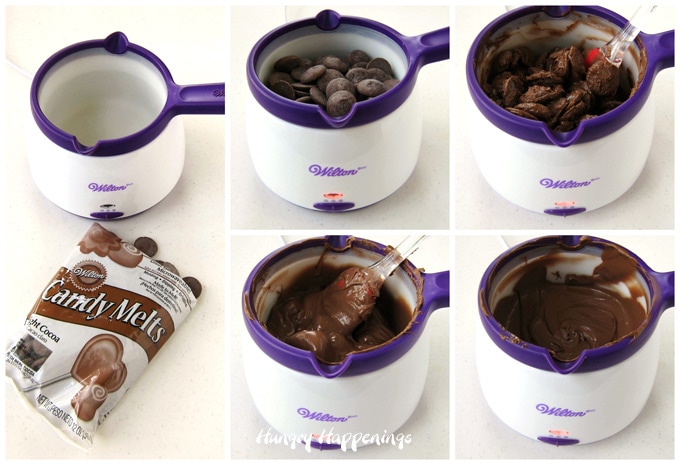
- Fill the silicone bowl in a Wilton Melting Pot with candy melts.
- Turn on low heat.
- Stir often, until the chocolate melts.
- If you use the high heat setting to melt the chocolate, be sure to stir it more frequently, then turn it down to low once the chocolate is melted.
- You can keep compound chocolate (candy melts) melted for hours using a melter.
Melting candy melts using an electric skillet.
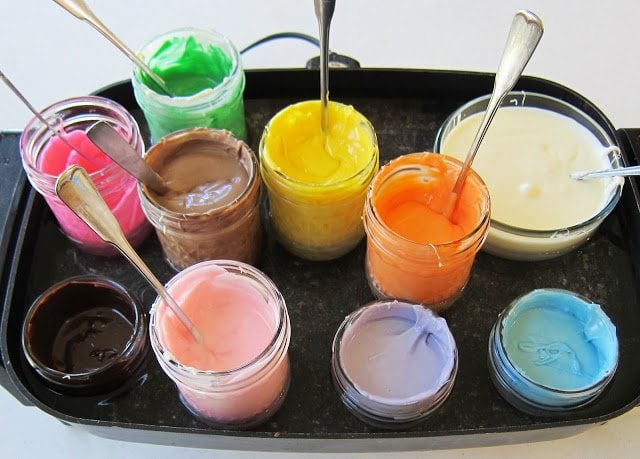
- Fill glass jars or coffee mugs with candy melts wafers.
- Set the jars into an electric skillet.
- Fill the skillet with an inch or two of hot water.
- Turn the skillet to the lowest setting. My skillet has a warm setting which works great.
- Allow the water to warm up and the candy melts to melt, stirring often.
- You can also melt the candy melts using the microwave then place the jars in the water bath in the skillet to keep them melted all day. Be sure to replenish the water as it evaporates.
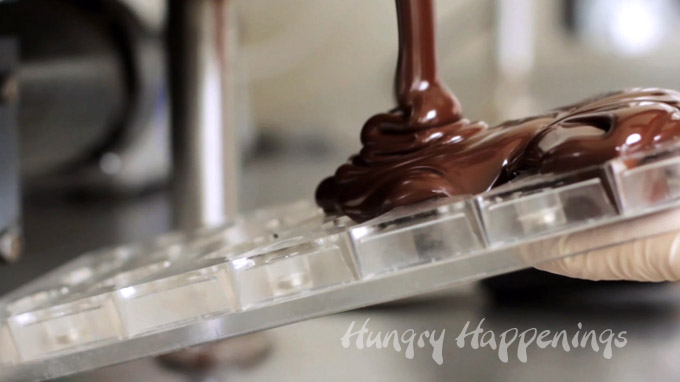
How to Temper Pure Chocolate?
Pure chocolate contains cocoa butter and when melted, the crystals in the cocoa butter lose their structure. In order to get that crystal structure back in alignment, you have to heat and cool the chocolate properly, so that the chocolate sets up properly.
Any chocolate that you purchase from the store that contains cocoa butter is already in temper but once you melt it, it can go out of temper if it gets too hot.
What does tempering mean?
Tempering refers to a process of heating and cooling pure chocolate to ensure that the cocoa butter in the chocolate hardens in a uniform crystal structure. When you buy pure chocolate, it is in temper. When you melt the chocolate to reuse it, you take it out of temper and need to bring it back.
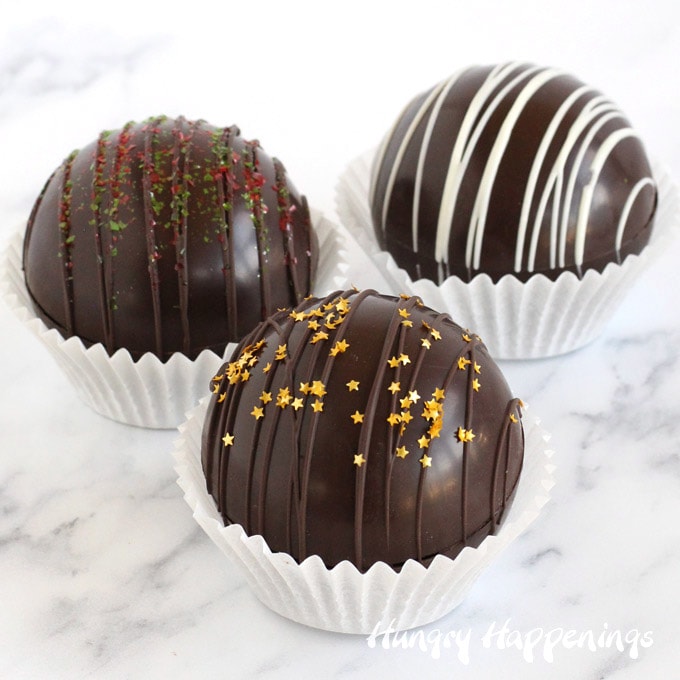
Chocolate that is tempered has:
- a smooth texture
- a glossy shine (like the hot chocolate bombs pictured above)
- snaps when broken
Chocolate that is not tempered correctly might be:
- cloudy
- gray
- sticky
- soft
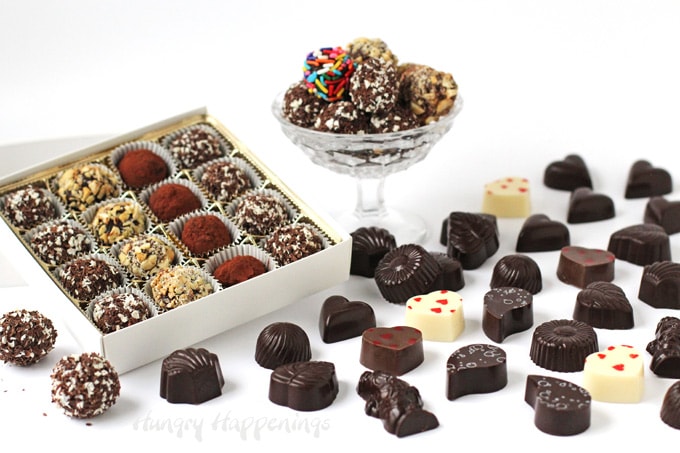
Learn to make these gorgeous truffles in my Chocolate Making Course
Easy Microwave Chocolate Tempering
If you are very careful, you can melt pure chocolate without taking it out of temper.
- Finely chop or grate your chocolate and place it in a microwave-safe bowl.
- Heat on high for 15 seconds, then remove the bowl and stir. Note: if using more than 12 ounces, you can start by heating it for 30 seconds.
- Then heat on high for 10 to 15-second increments, stirring after each, until melted. As you get close to melting, cut the heat to 50% power or the time to 5 seconds.
- When using this tempering method you want to be very careful not to get your chocolate too hot. You want the melted chocolate to be between:
- 88° F - 91° F (31° C - 32° C) for Dark Chocolate
- 86° F - 88° (30° C - 31° C) for Milk Chocolate
- 84° F - 86° (29° C - 30° C) for White Chocolate
- If the temperature of your chocolate goes above these numbers and you still have pieces of chocolate remaining in the bowl, continue to stir and allow that chocolate to melt. Check the temperature once all of the chocolate melts. If it is within the ranges listed above, your chocolate should be in temper.
- If the temperature of the melted chocolate is above the range, then you must use another method to temper the chocolate. I recommend the seeding method listed below.
Seeding Method of Tempering Chocolate
- Chop your chocolate into really fine pieces.
- Divide the chocolate and reserve 25% (¼) of it to seed the melted chocolate.
- Heat 74% (¾) of the chopped chocolate in the microwave on high power for 15 to 30-second increments, stirring after each.
- The heat in the bowl of melted chocolate will continue to help melt the solid pieces so as you get close to having all your chocolate melted, allow the chocolate to rest in the bowl for a minute before stirring.
- Heat until the chocolate melts and reaches:
- 115°-120° F (46°-49° degrees C) for dark chocolate
- 110°-115° degrees F (43°-46° C) for milk chocolate
- 110° F (43° C) for white chocolate
- Add about half of the reserved chocolate to the melted chocolate and stir until melted.
- Check the temperature of the chocolate. The goal is the get the chocolate to:
- 88° F - 90° F (31° C - 32° C) for Dark Chocolate
- 86° F - 88° (30° C - 31° C) for Milk Chocolate
- 84° F - 86° (29° C - 30° C) for White Chocolate
- Note that these temperatures can vary depending on the brand of chocolate.
- Continue to add a small amount of the remaining chocolate into the melted chocolate and stir until either all of the chocolate melts or your chocolate reaches the desired temperature.
- It’s best to stop at the upper end of the temperature range because the chocolate will continue to cool slightly as you are checking the temper.
- To check the temper, dip the end of a metal spatula or knife into the chocolate and allow all the excess chocolate to drip off. You want a really thin coating of chocolate on the spatula. If the chocolate dries hard and looks shiny, within 3-5 minutes, then the chocolate is in temper.
VIDEO
Watch the video to see how to temper chocolate using the seeding method.
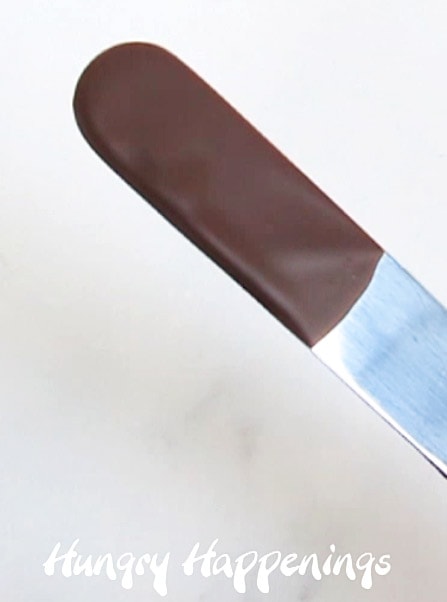
How to know if chocolate is in temper?
- Test the temper of the chocolate by dipping a metal spatula, spoon, or knife into the chocolate.
- Shake it, to remove the excess chocolate then set it aside at room temperature.
- In 3-5 minutes, the chocolate should harden and look shiny.
- Alternatively, you can spread a small amount of chocolate on a piece of parchment paper and allow it to air dry for 3-5 minutes. It should peel off the paper and snap when broken.
- While you are waiting, be sure to stir your bowl of chocolate, to make sure it doesn't cool too much around the edge.
- If your test chocolate has hardened and looks shiny be sure to check the temperature of your bowl of chocolate before proceeding to make your chocolate balls.
- The chocolate will have cooled slightly and will need to be warmed slightly!
- Heat it in the microwave for about 5 seconds then remove and stir and check the temperature. Do not let it go above temper temperature (88° milk or 84° white). If it does, you have to start this whole process over again.
- You are now ready to fill your molds with chocolate.
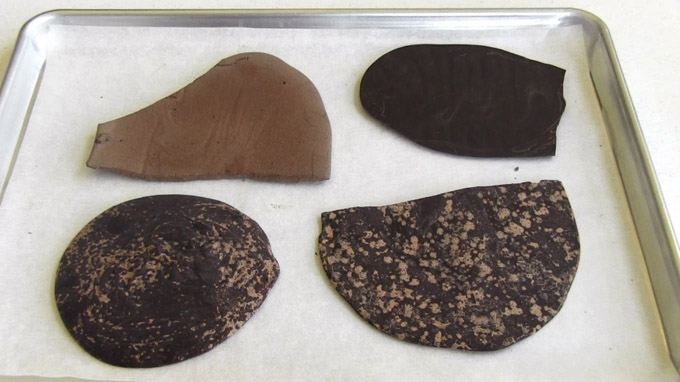
Can I skip tempering pure chocolate?
- NO. Do not skip tempering pure chocolate!
- Chocolate that is not tempered properly will be soft, streaky, spotty, or even chalky. The chocolate that is pictured above is all out of temper.
- Chocolate that is not properly tempered will not harden and retract from a mold.
How to keep chocolate in temper?
- To keep the chocolate in temper, you can heat the chocolate in the microwave for 3-5 seconds which is just long enough to warm it slightly.
- Or you can use a hot blow dryer, to heat up the bowl of chocolate, by blowing the hot air on the outside of the bowl.
- Keep an eye on the temperature of the chocolate. You don't want it to go above the temperatures listed above. If it does, then you'll need to start the tempering process again by raising the temperature to 115° F (46° C), seeing it with more tempered chocolate, and lowering the temperature to those listed above.
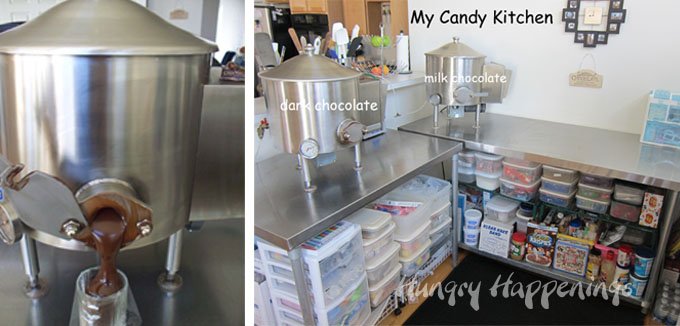
Chocolate Tempering Machines
If you are serious about making a lot of chocolate, you might want to consider buying some chocolate tempering machines.
I own two Savage Brothers melters and love them. I don't have to hand temper my chocolates. The machines do the work for me. It's great. I leave melted chocolate in my machines 365 days a year. I temper it as needed.
Each of my machines holds 50 pounds of chocolate, which is the smallest Savage Bros. makes, but other companies make smaller tabletop tempering machines. You can even get a machine that will temper just one or two pounds of chocolate at a time.
 ChocoVision Revolation Delt...Shop on Amazon
ChocoVision Revolation Delt...Shop on Amazon  ChocoVision Revolation 2 Ch...Shop on Amazon
ChocoVision Revolation 2 Ch...Shop on Amazon  HILLIARD'S Chocolate Temper...Shop on Amazon
HILLIARD'S Chocolate Temper...Shop on Amazon  ChocoVision Mini Rev Chocol...Shop on Amazon
ChocoVision Mini Rev Chocol...Shop on AmazonI prefer to use pure (real) chocolate to make my confections because the flavor is far superior to any other chocolate product.
I have made some really fun holiday treats using pure chocolate and shared the recipes and tutorials here on Hungry Happenings.

Using pure chocolate, you can make:
Buckeye Bears • Chocolate Cauldrons • Chocolate Heart Boxes • Chocolate Pilgrim Hats • Chocolate Penguin Truffles

Using Confectionery Coating, you can make lollipops, cake pops, filled candies, dipped cookies, Rice Krispie treats, and more including:
Chocolate Bunny Silhouettes, Candy Filled Chicks, Cake Ball Brains, Snowman Rice Krispies Treats, Animal Print Mickey Pops
If you prefer learning via video then be sure to check out my
Chocolate Making Courses at The Sugar Academy
Save 20% off using coupon code HUNGRYBLOG20
The videos feature 3 ½ hours of instructions and are broken down into 3 separate courses or one full-length bundle.
Can I use chocolate chips to make homemade chocolate?
Yes, but you need to know how to use them properly.
- Chocolate Chips can be pure chocolate or compound chocolate. You need to look at the ingredients to determine the type of chocolate.
- Pure chocolate chips will have cocoa butter listed in the ingredients and will need to be tempered.
- Most dark and milk chocolate chips are pure chocolate, but many white chocolate chips, like Nestle Premier White Morsels, are not, they are compound chocolates.
Chocolate Chips are:
- made to keep their shape in high heat
- melt very slowly
- have to be tempered if they contain cocoa butter
- come in semi-sweet, bittersweet, milk, white, peanut butter, butterscotch, and more flavors
- can be used as decoration on edible crafts
Should I add wax to chocolate chips when making homemade chocolate?
NO!
It is common practice in old candy-making recipes to add paraffin (wax) to melted chocolate chips so that the chocolate will set up properly. I don't advise this, as it adds a terrible mouthfeel and taste to the finished chocolates. Plus, who wants to eat wax? Not me.
If you use chocolate chips to make candies, you have to temper the chocolate in order for it to set properly. If you don't want to go through that much effort, then you are better off using confectionery coatings to make your candies.

You can use variations of chocolate chips and peanut butter chips to make sweet treats including:
Peanut Butter Starfish, Mini Pumpkin Cheesecake, Polar Bear Ice Cream Cones, Chocolate Chip Cookie Serving Bowl, Happy Chocolate Chip Cookies
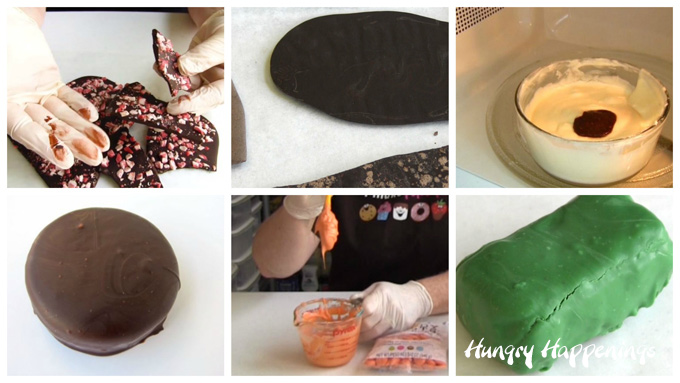
Troubleshooting Tips
When making homemade chocolate things can go wrong. Let's talk about how to fix the problems.
my chocolate is too soft and it melts too easily
- If your chocolate is too soft, like the peppermint bark shown above, it is not in temper. You must temper pure chocolate so that it hardens properly and has a good snap when broken.
- See the tempering instructions above.
my chocolate pieces have white spots or streaks
- Chocolate that has not been tempered properly or that has not been stored properly will develop white streaks and spots (fat bloom or sugar bloom). These spots are actually cocoa butter crystals that have separated from the cocoa solids.
- White spots and streaks in untempered chocolate may appear hours or days after your chocolate sets.
- See the tempering instructions above.
my chocolate is burnt
- If you overheat your chocolate in the microwave or on the stove it will burn.
- You cannot salvage burnt chocolate. It is ruined.
- Even if only a small portion of the chocolate looks like, like in the image above, the entire bowl of chocolate will taste burnt. Throw it all away, and start over.
- That's why I suggest using short bursts of power, stirring after each, when melting chocolate or candy melts in the microwave.
my chocolate is sticky and wet
- Chocolates that have been stored in the freezer or refrigerator will develop condensation (beads of water).
- To ensure your chocolate candies do not become sticky, store them at room temperature.
- If you do refrigerate or freeze your chocolate candies, wrap them well in plastic wrap, wax paper, or tin foil, then place them in a zip-top bag or airtight container. Thaw at room temperature in the packaging for several hours before unwrapping.
- If you are making homemade chocolates and they are left in the freezer or refrigerator for too long, they can become sticky too. So, be sure to remove your chocolate as soon as it hardens.
my melted candy melts are too thick
Compound chocolates (candy melts) can become thick for several reasons:
- they are heated to too high a temperature
- they have been stored improperly (in moist damp areas, in direct sunlight, near a heat vent, in the refrigerator or freezer)
- they are old (the older they get, the thicker they get)
- they have gone through drastic temperature changes (from hot to cold or cold to hot)
- they are exposed to moisture (even one drop of water or condensation can thicken your candy melts or chocolate)
To thin out thick candy melts:
- If once melted, your confectionery coating is really thick, add Paramount Crystals or Wilton Easy Thin which are flakes of palm kernel oil, to thin out the coating.
- Simply add a small pinch of the flakes and stir. If the candy melts are not thin enough, then add another small amount of the crystals and stir.
- You can use Crisco or vegetable oil instead, but your candy coating may be a bit soft once hardened.
You can thin pure chocolate or chocolate chips by adding some cocoa butter.
 Wilton EZ Thin Dipping Aid ...Shop on Amazon
Wilton EZ Thin Dipping Aid ...Shop on Amazon  CK Products Paramount Cryst...Shop on Amazon
CK Products Paramount Cryst...Shop on Amazon  Raw Cocoa Butter-16 oz. - N...Shop on Amazon
Raw Cocoa Butter-16 oz. - N...Shop on Amazon my chocolate is cracked
- Chocolate will crack when it's too cold.
- If you dip something into the chocolate and it's cold, the chocolate coating can crack. So be sure anything you dip in chocolate, like cake balls, or chocolate truffles, is at room temperature.
- If you are chilling compound chocolates (candy melts) in the freezer, be sure to remove the candy as soon as it has hardened. If candies are frozen for too long, they will crack.
BE SURE TO CHECK OUT THESE OTHER CHOCOLATE-MAKING TIPS TUTORIALS.
- How to Color White Chocolate or Confectionery Coating
- How to Use Colored White Chocolate to Paint Candy Molds to make Lollipops and more
- How to make Modeling Chocolate (chocolate clay) - Modeling Chocolate Recipe
- How to fix greasy, oily, dry, crumbly, or soft modeling chocolate (candy clay)
- How to roll out modeling chocolate
- How to Cut Modeling chocolate
- How to make Hot Chocolate Bombs
- How to make Chocolate Truffles
Learn more at The Sugar Academy
Save 20% off the chocolate making courses at The Sugar Academy using coupon code HUNGRYBLOG20
Now that you know the chocolate making basics you are ready to learn more.
Candy Clay Creations
If you want to learn all about making modeling chocolate (candy clay) be sure to also check out my book, Candy Clay Creations.
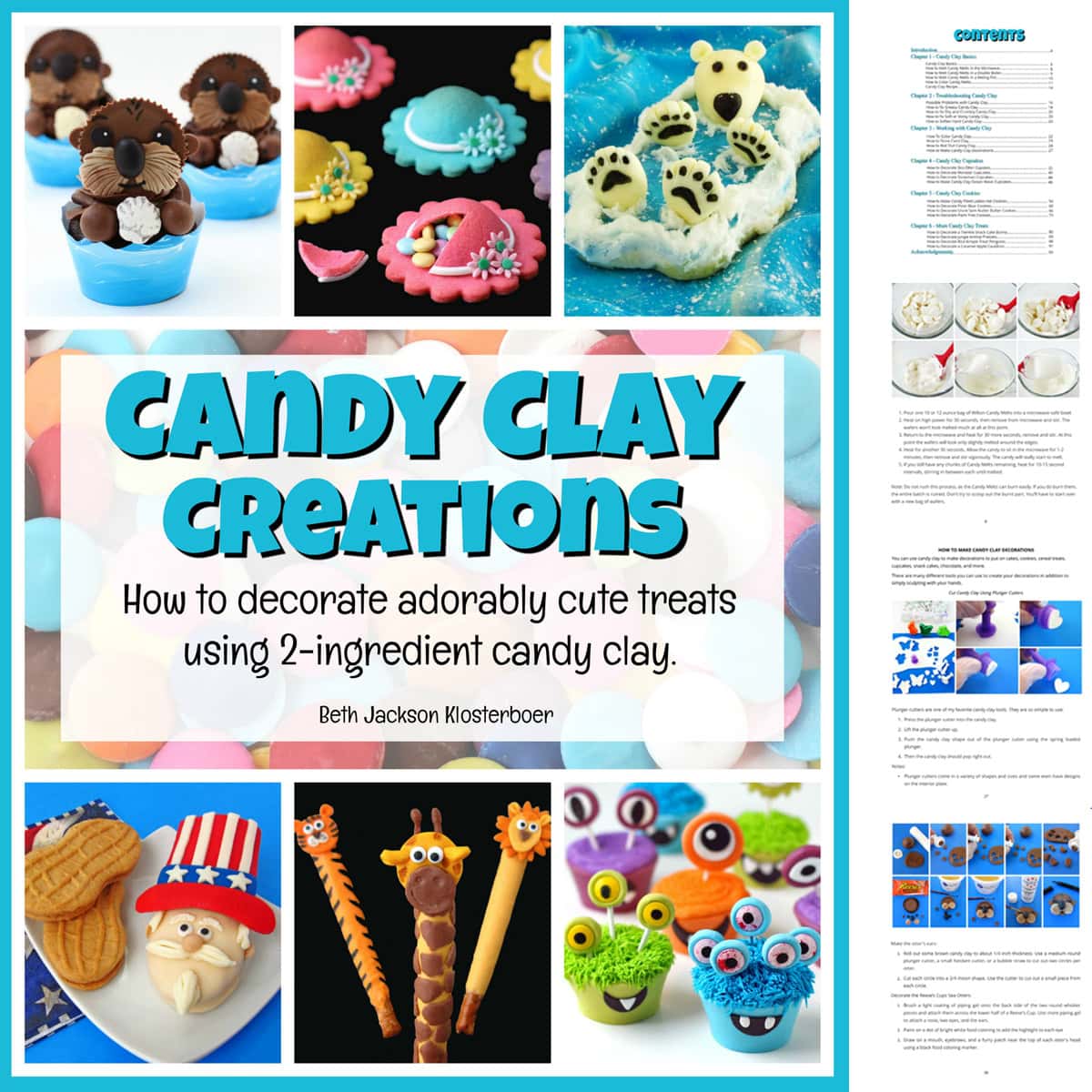
- Irresistible Sweets with Dixie Crystals® - July 13, 2024
- How to make peanut butter? - February 15, 2024
- OREO Penguins - December 20, 2023


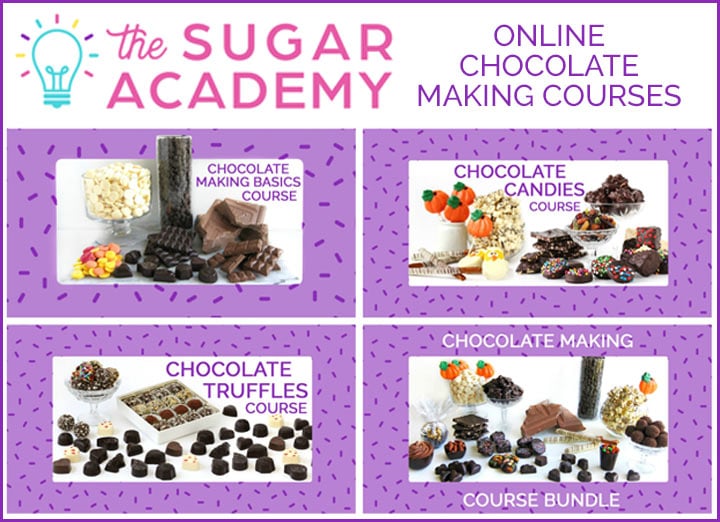
Haley says
Also! In your opinion, what is the best kind of chocolate to keep in a commercial warmer for dipping waffles in? I’d like the chocolate to harden up a bit after dipping, like donut icing sort of! If that makes sense! I’m making dipped waffles on a stick and am planning to make multiple throughout the day
Beth says
Most chocolates, if tempered properly will harden and should have good snap. If you want the chocolate to be softer then you can add some shortening to it or even coconut oil (this can add flavor to the chocolate depending on the coconut oil). I prefer using Peter's Burgundy or Callebaut chocolates but there are a lot of really delicious chocolates available.
Haley says
Hi!!!
I hope you see this! Will candy wafer melts stay melted in a commercial chocolate warmer? And what is the best oil to use to soften it up if needed?
Thank you!!!
Beth says
Hi Haley,
Yes, you can definitely keep candy melts melted in a commercial chocolate warmer. You want the candy melts to be held at about 110-115 degrees Fahrenheit. I recommend using Paramount Crystals or Wilton EZ Thin to thin out the candy melts. If there is a reason to soften the candy melts you can add shortening.
Tricia Jackson says
Hi! I was curious, for the purpose of making dipped truffles, do you use the Peters Burgundy 65? Also, which milk option do you like..there's 125, 160 or 90 (again, for making dipped truffles, as I have yet to learn how to do molded ones).
Thanks in advance!
Beth says
Hi Tricia,
Yes, when dipping truffles it is best to use thinner, lower viscosity chocolate like Burgundy 65 or a milk chocolate with a viscosity of 90. Use higher viscosity chocolate to make things like chocolate bark or clusters.
bblfoods7 says
I really appreciate all of this information. Thank you so much for sharing your knowledge.
Jan gatti says
When using pure chocolate can you add cream cheese and still mold it?
Beth says
I have never tried adding cream cheese to chocolate. I'm thinking it would make something similar to modeling chocolate which can be molded, but in a different way. It won't be liquid anymore. It will be more like clay which you might be able to push into a silicone mold, allow it to harden, then push it out. You won't be able to use a plastic or polycarbonate mold because the chocolate will never harden enough to pop out of a plastic mold. If you do try this, let me know how it works out. I might give it a go too.
dennis hahn says
Amazing Blog!! A person who is a beginner in the chocolate making must refer to your blog. The tips you shared about it are seamlessly awesome. I am surely going to follow your tips when making chocolate. Thanks for sharing that information too. Keep Sharing more..:)
Beth says
I'm so glad you found my chocolate making tips helpful. If you have any questions, don't hesitate to ask. Have fun!
Shannon says
I have antique bunny molds and tried making them for the first time last Easter. I melted a chocolate bar in the microwave and poured it in the molds, unfortunately they were not smooth and dark but whiteish and veiny.
You talk about tempering. What did I do wrong.....
Beth says
Hi Shannon,
Yes, your chocolate was out of temper. If you heat chocolate bars over 91 degrees Fahrenheit then they will go out of temper causing the chocolate to either be too soft to un-mold or to bloom, meaning the cocoa butter will separate out and come to the surface in the form of white streaks or spots. In order to get the chocolate back in temper you need to use one of several tempering methods. For instance you can melt chocolate to 115 degrees, then seed the chocolate by adding 1/3 more chocolate to the bowl of melted chocolate and stir it until it comes down to 91 degrees. At that point, you want to remove any un-melted pieces of chocolate then your chocolate is ready to mold.
The easiest way to use pure chocolate is to shave or grate it really finely then heat it really slowly in the microwave, 10-15 second bursts of low power, stirring after each interval until melted and heated to 90-91 degrees. (This temperature can vary slightly depending on the type of chocolate you use.) Using this method you can watch to make sure the chocolate never goes past 91 degrees F and the chocolate will never go out of temper. If using milk or white chocolate you want to maintain about 88 degrees F.
As I mentioned there are several methods to temper chocolate but the important thing to note is that anytime you are using pure chocolate that has cocoa butter listed in the ingredients it must be tempered. If you don't then the chocolate will not set properly, will oftentimes be too soft to remove from the mold and will always bloom, meaning the cocoa butter will separate from the chocolate causing white streaks and spots. This may not appear on the first day but will show up soon afterwards.
I'd suggest practicing using various methods of tempering and if you just can't get it to work out well, then opt for using confectionery coating instead. You never have to worry about tempering confectionery coating.
Good luck! - Beth
mycholatez says
Thank you for giving helpful advice. I always buy cocoa chocolate chips and store in heart shape or flower shape blocks, keeping in freezer. whenever i made the cake, cupcakes or cookies, i using this blocks. It gives fantastic look to my cookies.
juliana says
nao vou perder seus passos, eu quero aprenderrrrrr!!!! tudo sobre doces , as demoro em te visitar ,mas nao te esqueço. tudo 10
tina says
I enjoyed what I have read so far on your site, very thorough. I am trying to make milk chocolate frogs with rice krispies (for kids' summer camp). every website shows 2 ingredients, melting chocolate chips and stirring in rice krispies...no tempering and some people refrigerate to speed up the process.
do I need to temper, even if using chocolate chips that have cocoa butter? or do the rice krispies some how eliminate the need to temper? I do not want them to be streaky white but I need to make 200.
Beth says
Thanks, I'm glad you are finding my tutorials helpful. If you are making the frogs using chocolate chips, you will need to temper them in order for the frogs to set properly. If you don't temper the chocolate it will usually be too soft. It will never harden properly and it could stick to the mold. If it's tempered properly the chocolate will harden and shrink a bit which will make it easy to remove from the mold. The chocolate, if not tempered, will streak or become spotty, as well.
I highly recommend you use confectionery coating (candy melts) to make your frogs if you don't want to temper the chocolate. If you are making the frogs for kids, most of them aren't going to notice the difference between candy melts and pure chocolate. It will be less expensive and much easier.
Dani says
I've been making a number of different chocolate lollipops and am having a hard time finding a paint brush small enough to fill in letters and very fine details. I've even tried using a piping bag with #1 tip on occasion.....any suggestions on how to fill in those small spaces? Most of the brushes I've found are too wide.
Beth says
I use a fine tip paint brush to paint the fine details. The trick is to keep the paint brush clean and to dip it into the chocolate and only get a very small amount on the brush.
You can find a good brush here - http://amzn.to/1mQhL3X
Dani says
Great - thank you! One last question, which might seem silly but any tricks so that I can avoid the lollipop stick through the chocolate? I've tried banging on the counter first and then adding sticks but on occasion will still be able to see it.
Beth says
If the chocolate is thick the stick may not go in all the way. Try to fill the mold and insert a stick right away. If the chocolate is thin enough but the stick still shows through, the problem is the mold. They didn't leave enough room for the stick. If you are worried about the sticks coming out, you could harden the chocolate then brush a little extra chocolate over the area where the stick is showing. Have fun!
JB says
I tried to follow the microwave chocolate tempering instruction, but it doesn't make much sense. After I added the 1/4 chocolate to the melted 3/4, the whole thing turned into pretty thick dump that is not even stir-able. I ended up following the 15 seconds original melting procedures to remelt the whole batch and just use that. It turned out ok, as least it hardened. I don't understand the tempering mechanism at all.
Beth says
Sorry, you had trouble. Tempering definitely requires practice and being microwaves all heat differently, you may have to experiment a few times before getting it to work just right with your microwave.
Here's a link to an Alton Brown video where he uses the microwave to temper chocolate. He uses cocoa butter to temper the chocolate. It's a different method, but works well too. http://www.foodnetwork.com/recipes/alton-brown/microwave-chocolate-tempering-recipe.html
Minxxx says
You're website is chock full of helpful information and have bookmarked it for future referencing!
I have 1 simple question to ask and I'm sorry if it was covered in comments and replies somewhere but I did not have time to go thru all of them. I'm planning on making a lot of truffle filled chocolates for Christmas gifts, some will have transfers and others will be hand decorated and/or dipped. Can compound chocolate be used for decorating on tempered chocolate, in other words, will it adhere and set?
Beth says
Thanks! I have had some success painting candy coating into molds then allowing that to dry then pouring in the pure chocolate. I use this technique to paint my chocolate Easter bunnies. For the most part the two chocolates stay connected, but often times a pink nose or a white eye will fall off. So, it's not perfect, but it does work. If you try to add the compound chocolate (confectionery coating) decoration after the pure chocolate has set, you will need to make sure the coating is not hotter than the temperature of your tempered chocolate (88-91 degrees F) or you will throw the pure chocolate, around the decoration, out of temper and end up with bloom (white streaks) around the decoration.
babs says
It sounds like tempering just means melting? I'm looking for the easiest way to make your cute snowman pretzel cookies. I don't like those Wilton melting candies cause they are all artificial ingredients, so will just buy regular white chocolate. It sounds like finding wafers is the easiest way? And do it in the microwave at low setting. I think you said the word callet.
Beth says
HI Babs,
Tempering is not actually just melting. There is more to it that that. If you use pure white chocolate or dark chocolate and don't temper it, the chocolate will not ever set properly and will eventually bloom, which means it will develop white spots. If you serve the pretzels soon after you make them they might not develop the bloom, but will definitely be soft and possibly be sticky. Be sure to read my Chocolate Making Tips page for really detailed instructions.
Some people don't mind their chocolate being soft because the flavor of the pure chocolate is definitely better than the confectionery coating candy melts. It's up to you.
Callet just means small wafers. Companies who make pure chocolate wafers, call them callets.
I microwave my candy melts on high power, but for short amounts of time. Good luck and have fun!
beth says
To anonymous who asked about condensation on your lollipops, they aren't ruined, but will be sticky. The best you can do is to allow them to dry overnight at room a cool room temperature (70 degrees F or less.) The beads of sweat will dry, but will leave spots. You can at least package them though, so all is not lost.
Anonymous says
Oh Beth, I wish I had seen your site earlier! I've made over 100 chocolate pops and have put them in the fridge because it's so warm in the house....and now...you guessed it...condensation. What's a gal to do? Are my pops ruined? Can I fix this?
Thanks!
Julie Rawat says
Full Melt Chocolate is Colorado’s favorite infused chocolate candy bar.Full Melt chocolates are organic fair trade premier brand of medicated chocolate bars. full melt chocolates are too delicious.
Candy Gourmet says
that was neat how you designed all your candy's also go check this place out they have some really neat designs to http://www.myidolpops.com/
julie says
its nice post
beth says
To Mary Dixon who wrote:
I'm really struggling with my chocolate grand piano mold. I paint white chocolate on the keyboard of the piano first, then when its dry I pour the milk chocolate over the white and fill the mold. Problem: when I unmold the piano the chocolate comes out while the white keyboard stays in the mold. How do I fix this?
There could be a few reasons for this. One is that the mold is just not created well. Try filling the entire mold with one type of chocolate to see if it will all come out. Another problem can arise if you are using candy coating and pure chocolate together. They don't like to stick together. If you are only using one or the other, be sure to paint just a thin layer of white in the indentation, so that the milk chocolate fills in some of the space too. Tap the mold a few times to make sure the milk and white chocolate touch. That should help.